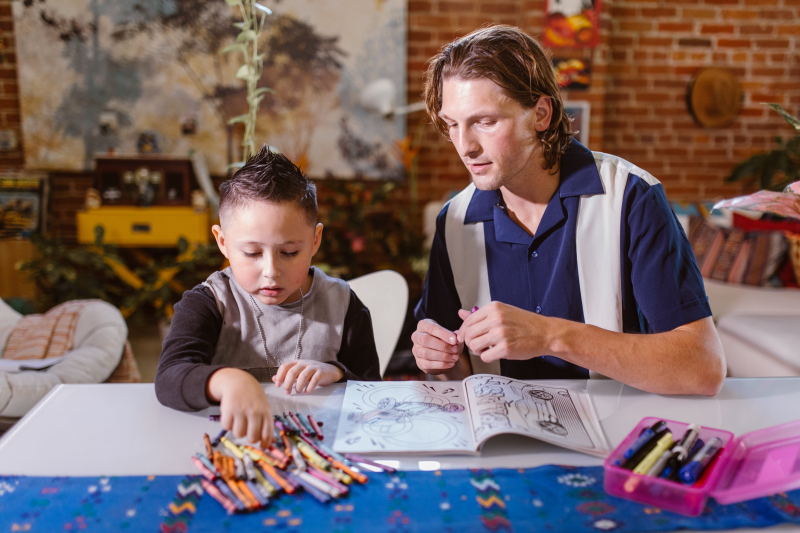Top 10 Compare and Contrast Essay Examples on Education & Parenting
Compare and contrast essays on education and parenting delve into the intricacies of learning and family dynamics. Toplist provides examples to illuminate the ... read more...unique dynamics that shape educational practices and parenting styles.
-
Essay topic: Public Schools and Private Schools.
Answer:
Education is a vital part of every individual's life, and students can attend either public schools or private schools. Both institutions play significant roles in shaping young minds, yet they differ in certain aspects, catering to diverse educational needs.
Public schools, funded by the government, are accessible to all students within a specific district. These schools aim to provide a free and equal education to every child. The curriculum in public schools is standardized and regulated by educational authorities, ensuring consistency across different schools.
On the other hand, private schools operate independently and are funded by tuition fees, donations, or endowments. These institutions often have more flexibility in shaping their curriculum and educational approach. Private schools may follow specific educational philosophies or religious principles, offering a unique academic experience.
One significant difference lies in the funding structure. Public schools receive government funding, allowing them to offer free education to all students. In contrast, private schools rely on various sources of funding, which can result in higher tuition fees for students and families.
Another aspect to consider is class size. Public schools often have larger class sizes due to the higher number of students. This can affect the teacher-to-student ratio and the level of individual attention each student receives. Private schools, with fewer students, may offer smaller class sizes, allowing for more personalized interactions between teachers and students.
In terms of extracurricular activities, both types of schools offer diverse options. However, private schools may have more resources to invest in extracurricular programs, including sports, arts, and special interest clubs.
In conclusion, public schools and private schools contribute significantly to the educational landscape. Public schools focus on providing accessible education to all, while private schools offer a more tailored approach, often with additional resources. The choice between them depends on factors such as individual preferences, educational philosophies, and the financial considerations of students and their families.

Photo by Pixabay via pexels 
Photo by Pixabay via pexels -
Essay topic: Online Learning and Classroom Learning.
Answer:
In the realm of education, students can embark on their learning journey through online courses or traditional classroom settings. Both approaches have distinct features, each offering unique advantages and challenges.
Online learning, facilitated through digital platforms, allows students to access educational materials and engage in lessons remotely. This method provides flexibility, enabling learners to set their own pace and study from anywhere with an internet connection. The virtual environment fosters self-discipline and independence in managing one's study schedule.
On the other hand, classroom learning takes place in a physical setting where students attend in-person lessons. This traditional approach involves face-to-face interactions with teachers and peers, creating a dynamic environment for discussions, group activities, and immediate feedback. Classroom learning provides a structured routine, allowing students to engage with the curriculum under the guidance of an instructor.
One significant difference is the level of personal interaction. Online learning relies on digital communication tools, which may limit direct interaction between students and teachers. While virtual discussions and forums exist, the absence of physical presence can sometimes hinder a deeper connection. Classroom learning, in contrast, thrives on immediate, in-person interactions, allowing for real-time engagement and a more personal connection between students and teachers.
Another aspect to consider is flexibility. Online learning accommodates diverse schedules, making it suitable for individuals with other commitments. Learners can access course materials at their convenience. In contrast, classroom learning follows a fixed schedule, requiring students to attend classes at specific times.
In terms of resources, online learning heavily relies on digital tools and platforms, offering a wide array of multimedia resources. This method fosters digital literacy skills. Classroom learning, however, involves physical textbooks, chalkboards, and other traditional resources that contribute to a tactile learning experience.
In conclusion, online learning and classroom learning each present distinctive approaches to education. Online learning offers flexibility and independence, making it suitable for those with varied schedules. Classroom learning, with its in-person interactions and structured routines, provides a traditional and dynamic educational experience. The choice between these methods depends on individual preferences, learning styles, and the specific needs of students.

Photo by Julia M Cameron via pexels 
Photo by Pixabay via pexels -
Essay topic: Sharing with Friends and Sharing with Siblings.
Answer:
Sharing is a fundamental aspect of human interactions, and it takes on different dynamics when it comes to sharing with friends and sharing with siblings. Both experiences offer unique insights into the dynamics of relationships and the act of sharing.
Sharing with friends is often a voluntary and reciprocal exchange. Friends willingly share belongings, experiences, and time with each other. This form of sharing is based on mutual trust and the desire to strengthen the bond between friends. It fosters a sense of camaraderie and creates shared memories, contributing to the growth of friendships.
In contrast, sharing with siblings is often a familial obligation. Siblings, as members of the same family, may share living spaces, belongings, and responsibilities. This type of sharing is not always voluntary but is expected within the family unit. It teaches the importance of cooperation and consideration for others, contributing to the development of a sense of family unity.
One significant difference is the nature of possessions being shared. With friends, the focus is often on sharing experiences, ideas, and non-material aspects. Friends may share emotions and support each other through challenges. Siblings, on the other hand, often share physical belongings such as toys, clothes, or living spaces, contributing to the development of a sense of communal ownership within the family.
Another aspect to consider is the influence of emotions. Sharing with friends is often driven by positive emotions such as joy, excitement, and a sense of companionship. Friendships thrive on shared laughter and experiences. In contrast, sharing with siblings can sometimes involve a range of emotions, including occasional conflicts over possessions or personal space. These experiences contribute to the development of conflict resolution and communication skills within the family.
In conclusion, sharing with friends and sharing with siblings each offer valuable lessons in human relationships. Sharing with friends emphasizes voluntary and reciprocal exchanges, fostering friendships through shared experiences. Sharing with siblings, rooted in familial obligations, teaches cooperation and the importance of communal living. Both forms of sharing contribute to the development of interpersonal skills and the building of meaningful connections in different social contexts.

Photo by Pixabay via pexels 
Photo by cottonbro studio via pexels -
Essay topic: Authoritative and Permissive Parenting.
Answer:
Parenting styles greatly influence the upbringing of children, and two common approaches are authoritative and permissive parenting. These styles differ in their expectations, rules, and the overall atmosphere they create in the family.
Authoritative parenting is characterized by clear expectations and consistent rules. Authoritative parents set reasonable limits for their children while also providing warmth and support. This parenting style fosters a positive environment where children feel secure. Communication is open, and parents actively engage with their children, offering guidance and explanations for the rules in place. This approach aims to balance structure with emotional support, encouraging independence and responsibility.
On the other hand, permissive parenting is marked by a more relaxed approach. Permissive parents tend to be lenient with rules, allowing their children considerable freedom. This parenting style emphasizes warmth and responsiveness but may lack clear boundaries. Permissive parents often avoid strict discipline and prioritize nurturing a close relationship with their children. While this approach encourages creativity and independence, it may sometimes lead to challenges in setting consistent expectations.
One significant difference is the level of control. Authoritative parenting involves setting clear expectations and enforcing rules while remaining responsive to a child's needs. This approach instills a sense of accountability and respect for authority. In contrast, permissive parenting involves fewer restrictions, offering more freedom for children to express themselves. While this can enhance creativity, it may sometimes result in a lack of structure and accountability.
Another aspect to consider is the impact on a child's behavior. Authoritative parenting often leads to children who are self-disciplined, confident, and capable of making responsible decisions. The clear expectations set by authoritative parents contribute to the development of strong character traits. Permissive parenting, while fostering independence, may sometimes result in children who struggle with self-control and respecting authority, as they may not have experienced consistent boundaries.
In conclusion, authoritative and permissive parenting represent two distinct approaches to raising children. Authoritative parenting emphasizes a balance between rules and warmth, aiming for a structured yet supportive environment. Permissive parenting, while nurturing independence, tends to be more lenient with rules. The choice between these styles depends on cultural factors, individual preferences, and the unique needs of each child within the family.

Photo by Kindel Media via pexels 
Photo by Gustavo Fring via pexels -
Essay topic: Single Parenting and Dual Parenting.
Answer:
Parenting comes in various forms, and two common structures are single parenting and dual parenting. These approaches to raising children differ in terms of family dynamics, support systems, and the overall environment they create.
Single parenting involves one parent taking on the responsibility of raising a child alone. This structure may result from various circumstances, such as divorce, separation, or the choice to raise a child independently. Single parents bear the weight of decision-making, providing emotional and financial support, and managing household responsibilities solo. This parenting style demands resilience and resourcefulness, as the single parent juggles multiple roles.
In contrast, dual parenting involves both parents actively participating in the upbringing of their children. This structure is often associated with married or cohabiting couples. Dual parents share the responsibilities of decision-making, emotional support, and managing household duties. This approach allows for a division of tasks, providing a support system where both parents contribute to the well-being of the family.
One significant difference is the distribution of responsibilities. Single parenting requires the sole caregiver to handle all aspects of parenting, from making decisions to managing daily tasks. This can be challenging, demanding a high level of self-reliance. Dual parenting, on the other hand, allows for a shared distribution of responsibilities, creating a more collaborative environment where both parents contribute to various aspects of their children's lives.
Another aspect to consider is the emotional support system. Single parenting may sometimes involve a more limited emotional support network, as one parent carries the emotional burden alone. In dual parenting, the presence of both parents provides a broader support system for children, offering diverse perspectives and shared emotional support.
In terms of financial resources, dual parenting may potentially benefit from dual incomes, allowing for more financial stability. Single parenting, however, may face financial challenges as the sole provider manages expenses independently.
In conclusion, single parenting and dual parenting represent distinct family structures, each with its own challenges and advantages. Single parenting demands resilience and self-reliance, while dual parenting provides a collaborative environment with shared responsibilities and a broader emotional support system. The effectiveness of each approach depends on individual circumstances, personal choices, and the ability of parents to navigate the unique challenges of their chosen parenting structure.

Photo by Gustavo Fring via pexels 
Photo by Emma Bauso via pexels -
Essay topic: Strict Discipline and Positive Reinforcement.
Answer:
Parenting styles vary, and two common approaches are strict discipline and positive reinforcement. These methods differ in their strategies for guiding children's behavior, shaping their character, and fostering a supportive environment.
Strict discipline involves setting clear rules and expectations for children, with consequences for not adhering to them. This approach emphasizes obedience and often includes specific rules that children are expected to follow without question. Strict discipline aims to establish authority and ensure that children understand the consequences of their actions. Parents using this approach may rely on punishments to deter undesirable behavior.
In contrast, positive reinforcement focuses on acknowledging and rewarding good behavior. This approach emphasizes encouragement and praise when children exhibit positive actions. Parents using positive reinforcement often reinforce desired behavior with verbal praise, small rewards, or other positive affirmations. The goal is to create a positive environment that motivates children to continue exhibiting good conduct.
One significant difference is the approach to correcting behavior. Strict discipline relies on consequences, such as timeouts or loss of privileges, to deter undesirable behavior. The focus is on discouraging negative actions through punishments. On the other hand, positive reinforcement emphasizes rewarding positive behavior, reinforcing a connection between good conduct and positive outcomes.
Another aspect to consider is the impact on a child's mindset. Strict discipline may instill a sense of fear or obedience in children, as they learn to associate misbehavior with negative consequences. While this approach may lead to immediate compliance, it may not necessarily foster a deep understanding of the reasons behind the rules. Positive reinforcement, on the other hand, cultivates a more positive mindset, encouraging children to internalize good behavior by associating it with positive experiences and affirmations.
In terms of communication, strict discipline may involve more directives and commands, focusing on what children should not do. Positive reinforcement, however, often includes more affirmations and positive statements, guiding children toward desired behavior by highlighting their positive actions.
In conclusion, strict discipline and positive reinforcement represent distinct approaches to parenting. Strict discipline relies on clear rules and consequences to guide behavior, emphasizing obedience. Positive reinforcement, on the other hand, fosters a positive environment, encouraging good behavior through acknowledgment and rewards. The effectiveness of each approach depends on individual preferences, cultural factors, and the unique needs of each child within the family.

Photo by Monstera Production via pexels 
Photo by Andrea Piacquadio via pexels -
Essay topic: Attachment Parenting and Detachment Parenting.
Answer:
Parenting styles play a crucial role in shaping a child's development, and two contrasting approaches are attachment parenting and detachment parenting. These styles differ in their strategies for nurturing, bonding, and fostering independence in children.
Attachment parenting centers on creating a strong emotional bond between parents and children. This approach emphasizes close physical contact, such as baby-wearing and co-sleeping, to enhance the parent-child connection. Attachment parents often respond promptly to their child's needs, aiming to build a secure attachment that fosters trust and emotional well-being. This approach encourages a nurturing environment where children feel emotionally supported.
In contrast, detachment parenting focuses on promoting independence and self-reliance in children from an early age. This approach encourages a degree of separation to allow children to develop their autonomy. Detachment parents may prioritize a more hands-off approach, allowing children to explore and learn on their own. The goal is to instill a sense of self-sufficiency and resilience.
One significant difference is the emphasis on physical closeness. Attachment parenting encourages close physical contact, with practices like co-sleeping and baby-wearing reinforcing the parent-child bond. The physical presence of the parent is considered a source of comfort and security. Detachment parenting, however, may involve more physical space, allowing children to explore and develop their independence without constant physical closeness.
Another aspect to consider is the approach to responding to a child's needs. Attachment parenting prioritizes immediate responses to a child's needs, aiming to create a sense of security and trust. Parents using this approach often believe in being attuned to their child's emotional cues. Detachment parenting, on the other hand, may involve a more measured response, allowing children to learn problem-solving skills and self-soothing techniques.
In terms of fostering independence, attachment parenting focuses on building a strong foundation of emotional security before encouraging independence. In contrast, detachment parenting believes in fostering independence from the early stages, allowing children to develop self-reliance through exploration and decision-making.
In conclusion, attachment parenting and detachment parenting represent two distinct approaches to nurturing and guiding children. Attachment parenting prioritizes emotional closeness and immediate responses, aiming to build a secure attachment. Detachment parenting, on the other hand, emphasizes independence and self-reliance, allowing children to explore and develop autonomy from an early age. The choice between these approaches often depends on individual parenting philosophies and the unique needs of each child within the family.

Photo by Elina Fairytale via pexels 
Photo by Kindel Media via pexels -
Essay topic: Early Childhood Education and Delayed Formal Education.
Answer:
Approaches to education vary, and two contrasting methods are early childhood education and delayed formal education. These strategies differ in their timing, methodologies, and overall philosophy toward the learning journey of children.
Early childhood education involves introducing formal learning experiences to children at a young age. This approach emphasizes structured educational activities, often through play-based and interactive methods. Early childhood education aims to stimulate cognitive development, social skills, and a love for learning from the early years. Proponents believe that an early start to formal education contributes to a solid foundation for future academic success.
In contrast, delayed formal education suggests postponing the introduction of structured learning until a later age. This approach emphasizes a more informal and experiential learning environment during the early years. Delayed formal education allows children to explore and learn through everyday experiences, promoting a more natural development of cognitive and social skills. Proponents believe that delayed formal education fosters a love for learning by allowing children to discover their interests and passions before entering a structured academic setting.
One significant difference is the timing of formal learning. Early childhood education introduces structured learning experiences from the preschool years onward, often before formal schooling begins. The focus is on creating a foundation of academic and social skills during the early developmental stages. Delayed formal education, however, suggests waiting until a later age, allowing children to engage in unstructured learning experiences during their early years.
Another aspect to consider is the methodology of learning. Early childhood education often involves structured lessons and activities designed to enhance specific skills. The emphasis is on intentional teaching. Delayed formal education, in contrast, prioritizes a more child-led approach, allowing children to learn through exploration and everyday experiences, emphasizing the natural curiosity of childhood.
In terms of social development, early childhood education introduces children to structured social environments from an early age, fostering interaction and cooperation. Delayed formal education, on the other hand, believes in allowing children to naturally develop social skills through unstructured play and interactions with peers.
In conclusion, early childhood education and delayed formal education represent two distinct approaches to the early learning experiences of children. Early childhood education emphasizes structured learning from the preschool years onward, aiming to create a solid foundation. Delayed formal education suggests postponing structured learning, allowing children to explore and learn through natural experiences during their early years. The effectiveness of each approach depends on individual preferences, cultural factors, and the unique needs of each child within the educational journey.

Photo by RDNE Stock project via pexels 
Photo by Katerina Holmes via pexels -
Essay topic: Helping with Chores and Helping with Homework.
Answer:
Contributing to household tasks and academic responsibilities are crucial aspects of a student's life, and two common ways children can help are by assisting with chores and aiding with homework. These activities differ in their nature, purpose, and the skills they foster.
Helping with chores involves participating in household tasks, such as cleaning, organizing, or assisting with meal preparation. This form of contribution teaches children responsibility, time management, and cooperation. When helping with chores, children learn the importance of maintaining a clean and organized living space, contributing to the overall well-being of the family. This form of assistance promotes a sense of shared responsibility and fosters practical life skills.
On the other hand, helping with homework focuses on academic support. This involves aiding a student in understanding and completing their school assignments. Helping with homework requires patience, communication, and a willingness to reinforce the concepts learned in the classroom. This type of assistance contributes to the academic success of the student, reinforcing the importance of education and self-discipline.
One significant difference is the context of the activities. Helping with chores occurs within the home environment and involves tasks related to maintaining the household. It emphasizes the importance of contributing to the family's daily life and instills a sense of responsibility for the shared living space. In contrast, helping with homework is directly connected to academic responsibilities, extending the learning process beyond the classroom and emphasizing the value of education.
Another aspect to consider is the skills developed through each activity. Helping with chores enhances practical life skills, teaching children how to manage their time, work collaboratively, and take responsibility for their immediate environment. This form of assistance contributes to the development of a strong work ethic and the ability to contribute to a collective goal. Helping with homework, on the other hand, focuses on academic skills, including critical thinking, problem-solving, and effective communication. This type of assistance reinforces the value of education and the importance of investing time in learning.
In conclusion, helping with chores and helping with homework represent two distinct ways children can contribute to the family and their academic success. Helping with chores teaches practical life skills and promotes a sense of responsibility for the household. Helping with homework focuses on academic support, reinforcing the importance of education and developing critical thinking skills. Both forms of assistance contribute to the overall development of responsible, engaged, and capable individuals within the family and academic settings.

Photo by cottonbro studio via pexels 
Photo by Pixabay via pexels -
Essay topic: Parental Involvement in Education and Non-Involvement.
Answer:
The role of parents in a child's education can vary significantly, with two distinct approaches being parental involvement and non-involvement. These approaches differ in terms of the level of engagement, impact on a child's academic journey, and overall contribution to their learning experience.
Parental involvement in education signifies active participation and support from parents in a child's academic life. This includes attending parent-teacher meetings, assisting with homework, and engaging in discussions about school experiences. When parents are involved in their child's education, it fosters a positive learning environment, encourages a sense of responsibility, and contributes to a child's overall academic success. This form of involvement emphasizes the collaboration between parents and educators to support a child's learning journey.
In contrast, non-involvement suggests a lack of active participation from parents in their child's educational activities. This may manifest as limited communication with teachers, minimal involvement in homework assistance, and a general detachment from a child's school experiences. When parents are not involved in their child's education, it can impact the child's motivation, overall academic performance, and their perception of the value of education. This approach may hinder the development of a positive attitude towards learning.
One significant difference is the level of support provided to a child's academic journey. Parental involvement offers a support system that extends beyond the classroom, reinforcing the importance of education and providing additional assistance when needed. It fosters a sense of collaboration between parents and teachers, creating a holistic learning experience for the child. On the other hand, non-involvement may result in a lack of support, leaving the child to navigate their academic challenges independently.
Another aspect to consider is the impact on a child's motivation and attitude towards learning. Parental involvement often contributes to a positive attitude, as children feel supported and valued in their academic pursuits. This form of involvement reinforces the idea that education is a shared responsibility between parents, educators, and the student. Conversely, non-involvement may lead to a lack of motivation, as children may perceive education as a solitary journey without significant external support.
In conclusion, parental involvement in education and non-involvement represent two distinct approaches to a child's academic journey. Parental involvement emphasizes active participation, collaboration with educators, and additional support, contributing to a positive attitude towards learning. Non-involvement, on the other hand, suggests a lack of active engagement, potentially impacting a child's motivation and overall academic experience. The level of parental involvement can significantly influence a child's educational success and their perception of the value of education.

Photo by Daria Obymaha via pexels 
Photo by Pixabay via pexels





















